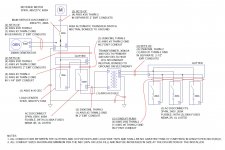I asked in the other thread about the 480/277V tap regarding the smaller conductor sets going to the disconnect and the panel board - which is the feeder and which is the tap - and I got the answer that they were both taps. Fair enough, but if I can attach two sets of conductors to a tap, then why not three? Why is two sets of smaller conductors connected to the end of a feeder not tapping a tap but three sets is?
Here's a textual version of your one line, with labels on each line of the various terms in use. Each line of text is a cross section with one item or several similar parallel items, and there is connectivity from each line of text to the next one.
Utility
400A conductors (Service Conductors)
400A OCPD
400A conductors (Feeder, not a tap)
(100A, 300A) conductors (Feeder taps)
(100A, 300A) disconnects
300A conductors (Feeder, not a tap, omitting the 100A branch henceforth)
Transformer primary
Transformer secondary
600A conductors (Feeder, secondary conductors, no OCPD at source of supply)
600A OCPD (not shown, but required per 240.21(C))
(200A, 200A, 200A) conductors (Feeder taps)
(200A, 200A, 200A) disconnects
The point is that the 600A conductors connected to the transformer secondary do not have OCPD at their point of supply (which is the transformer secondary), and thus do not comply with the first sentence of 240.21. Therefore they may not supply another conductor except through OCPD, and must meet one of the subsections of 240.21, in this case 240.21(C). Thus you need the 600A OCPD I listed.
If you change it to:
. . .
Transformer secondary
(200A, 200A, 200A) conductors (Feeders, secondary conductors, no OCPD at source of supply)
(200A, 200A, 200A) disconnects
Then that complies with 240.21(C), and you don't need the 600A OCPD.
Cheers, Wayne

